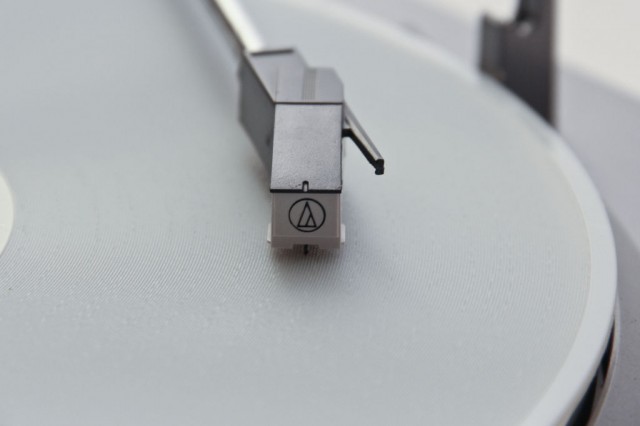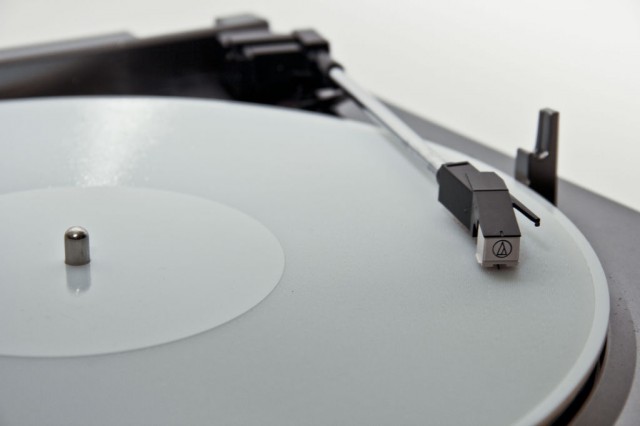3D printing is transforming digital information into objects in ways we haven’t seen before. However, a project has been making the rounds through online media partly because it recalls a familiar object: the musical record. Amanda Ghassaei’s 3D-printed record sounds crude, but it makes clear the connection of data to printed, physical form: take a music file, make a printed album.
Amanda writes:
I’m a really big fan of your blogs and I thought you might like a project I’ve recently published on instructables:
I managed to actually print a working (although quite noisy) record on a 3D printer. I wrote a Processing sketch that converts raw audio data to a 3D model of a record and printed these records out with an Objet Connex500 resin printer.
I find myself fascinated by the sound partly because it doesn’t sound like the original; it seems 3D printing has gotten as far as early phonograph technology. But here, CDM talks to Amanda more about what this demonstration means, some related projects, and where this may all be heading.
3D Printed Record from Amanda Ghassaei on Vimeo.
CDM: Apart from proof of concept, how do you imagine this might be used? And what would it take to get a method that was more sonically accurate?
Amanda: The real draw of this 3D printing in general is that it allows people to create customizable objects on demand. 3D printing doesn’t scale well for high-volume manufacturing, so it will never replace traditional techniques of record production, but I think as the resolution, techniques, and materials get better and cheaper, maybe we could see independent artists and tinkerers using this technology in interesting ways. I imagine 3D-printed records will be used for creative, experimental, or purely frivolous purposes, now and in the future, but who knows. I really wanted to record my own Christmas album (I’m a horrible singer) and give it to my family for Christmas this year, but I got so busy getting this project published that I ran out of time. It’s definitely in the works for next year…
As for increased accuracy, I have some ideas about how to improve the audio quality without having to increase the printer’s resolution. Hopefully I can try a few of these out over the weekend.

Groovin’: the 3D file represents a lot of geometry and data, says Amanda. All images courtesy the artist.
The first is RIAA equalization. I didn’t know this before I published this project, but all audio goes through a special EQ before it’s sent to a normal lathe record cutter; basically what it does is increase the amplitude of the higher frequencies and lower the bass. The needle mechanism of a turntable has a better frequency response to low frequencies, so it will naturally make things sound more bass heavy, and the RIAA equalization helps to counteract this effect. Some of the loss of higher frequencies in my records is due to the lowered sampling rate, but I think adjusting the EQ could help to bring out the highs a little more.
The second is higher RPM [rotations per minute]: with the record spinning at a faster speed, I can increase the sampling rate to about 16kHz at 45RPM and up to about 22kHz at 78RPM. I stuck with 33 RPM for these first tests because I wanted this project to be as close to the real thing as possible, and I wanted to maximize the amount of audio I could fit on each side – at 33 RPM I can get about 5-6min per side, at 78, this goes down to about 2-3min.
The last thing is the needle. The older needles used for 78s are about three times thicker than needles used for more modern, microgroove records. Since the grooves on my records are considerably larger than normal — about 10x as wide — I think the larger needle might be a little more stable and decrease noise. If I can find a 78 needle that fits my turntable, I’ll definitely give this a try.
Beyond this, increased printing resolution and new printing techniques are the only way to get these records up to a reasonable fidelity. If you listen closely to the recordings I’ve made, you’ll hear a repetitive whirring noise, a frequency sweep. This is actually caused by tiny parallel groves on the surface of the print, a side effect of the 600dpi resolution of the print head; every time the needle moves perpendicularly to these grooves, it introduces an extra noise into the output. A printer that could deposit material in a vector path, as opposed to raster, would help to remove these types of artifacts. Another interesting problem with my records is that the inner grooves have a considerably lower sampling rate than the outer grooves (I talk about this in a lot of detail in step 2 of my instructable). Basically, this is an issue of trying to map a Cartesian coordinate system on an object that is inherently polar, so maybe developing a printer that prints in a polar coordinate system would be better for this particular application.

More 3D printed records: here, for a Fisher Price toy player (and thus, more of the music-box variety, representing notes rather than audio signal).
Do you know of any related projects people might want to look at? (I saw one that used records in ice.)
Yes, those ice records were cool!
There’s the 3D printed and CNC-milled records for the Fisher Price toy record player on Instructables:
http://www.instructables.com/id/3D-printing-records-for-a-Fisher-Price-toy-record-/
http://www.instructables.com/id/Custom-records-for-a-70s-toy-record-player/
Ed.: I wrote about that project briefly in 2008.
my project used a library to export STL from Processing called “ModelBuilder,” it’s really well organized and works great. [Ed.: There’s a specific tutorial for 3D printing. May have to give this a try myself! -PK] I’m excited to use this library more in the future; I love the idea of creating 3D models by algorithm – lots of room for experimentation and complexity. You can read about it and download it here:
http://workshop.evolutionzone.com/2011/04/06/code-modelbuilder-library-public-release/
and here’s a collection of Processing sketches that use the library- I’ll be adding mine there as soon as I get the chance. (for now all my code is on Instructables):
http://www.openprocessing.org/collection/1768
Another thing I thought was cool, but nobody’s really talked about:
Aside from the resolution limits, the biggest obstacle I had to contend with was managing the huge amount of data stored in these record models. To give you a point of reference – one side of each of my discs can store about 5-6min of audio at 33rpm, and the resulting 3D model is comprised of about 25-30 million triangular faces. That’s 1.2-1.5GB of data. It’s pretty ridiculous really, I was essentially converting a 50MB WAV file into a 1.5GB STL [3D file]. I had to use a computer with 16GB of RAM just to export these files from Processing. After that, the printer software has to do a bunch of preprocessing on the model to convert it from a vector-based STL file into 130 rastered layers. For now, the machine running our printer only has about 4GB of RAM; this was only powerful enough to handle files up to 250MB, or about 1 min of audio, so that’s all I’ve been able to print so far. We’re in the process of upgrading that machine, so I’m hoping to finally print out a complete 5-6min side soon.
I talk a little bit in step 5 of my instructable about how I changed the algorithm to minimize the amount of data packed in the models. there are definitely ways of making it even more efficient (lowering the resolution of the inside of the disc, as each revolution becomes shorter in length), but I just haven’t had time to experiment with it yet.
Here’s that ice record project from the Shout Out Louds, for good measure.
From comments on YouTube:
Let me explain how we have done it. The mold is made out of two pieces. One negative 7″ vinyl cut made by a record plant in Germany from the original audio master and one silicon cap, the sole purpose of which is to hold the water still while freezing.
More detail on Fast Company’s design blog:
A Record Made Of Ice That Actually Plays

3D printing isn’t the only way to create new, playable music objects. Here’s a record made of molded ice.
We’ll continue this 3D printing conversation going on CDM. We’d love to see what you’re working on – especially if someone else takes on that Processing library. (Records could be just the beginning.)
Don’t miss Amanda’s site for other terrific work:
http://www.amandaghassaei.com/

